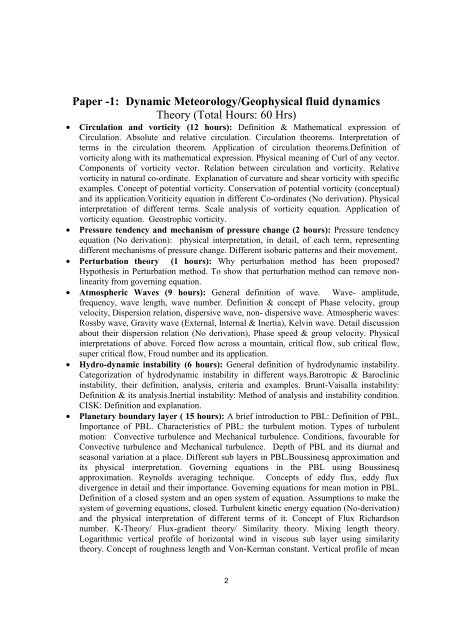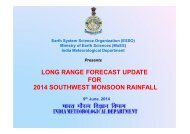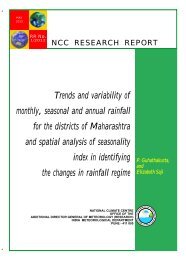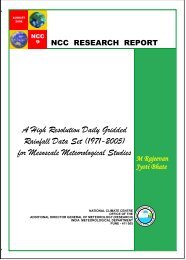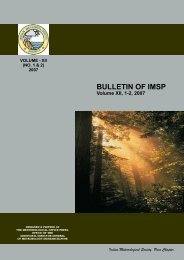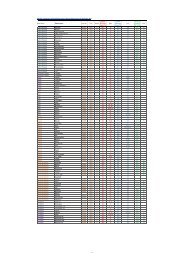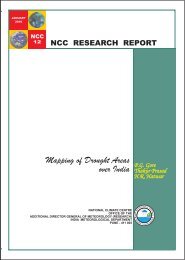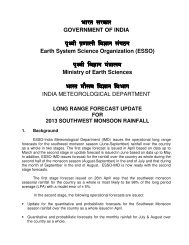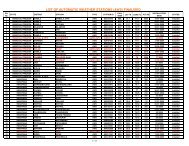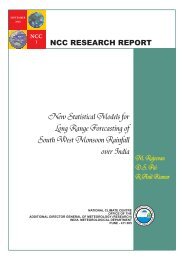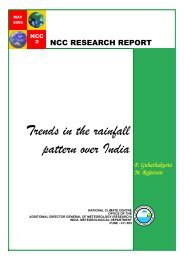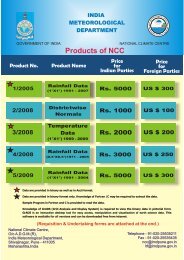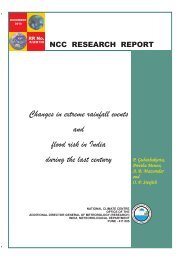5 India Meteorological Department Central Training ... - (IMD), Pune
5 India Meteorological Department Central Training ... - (IMD), Pune
5 India Meteorological Department Central Training ... - (IMD), Pune
Create successful ePaper yourself
Turn your PDF publications into a flip-book with our unique Google optimized e-Paper software.
Paper -1: Dynamic Meteorology/Geophysical fluid dynamicsTheory (Total Hours: 60 Hrs)• Circulation and vorticity (12 hours): Definition & Mathematical expression ofCirculation. Absolute and relative circulation. Circulation theorems. Interpretation ofterms in the circulation theorem. Application of circulation theorems.Definition ofvorticity along with its mathematical expression. Physical meaning of Curl of any vector.Components of vorticity vector. Relation between circulation and vorticity. Relativevorticity in natural co-ordinate. Explanation of curvature and shear vorticity with specificexamples. Concept of potential vorticity. Conservation of potential vorticity (conceptual)and its application.Voriticity equation in different Co-ordinates (No derivation). Physicalinterpretation of different terms. Scale analysis of vorticity equation. Application ofvorticity equation. Geostrophic vorticity.• Pressure tendency and mechanism of pressure change (2 hours): Pressure tendencyequation (No derivation): physical interpretation, in detail, of each term, representingdifferent mechanisms of pressure change. Different isobaric patterns and their movement.• Perturbation theory (1 hours): Why perturbation method has been proposed?Hypothesis in Perturbation method. To show that perturbation method can remove nonlinearityfrom governing equation.• Atmospheric Waves (9 hours): General definition of wave. Wave- amplitude,frequency, wave length, wave number. Definition & concept of Phase velocity, groupvelocity, Dispersion relation, dispersive wave, non- dispersive wave. Atmospheric waves:Rossby wave, Gravity wave (External, Internal & Inertia), Kelvin wave. Detail discussionabout their dispersion relation (No derivation), Phase speed & group velocity. Physicalinterpretations of above. Forced flow across a mountain, critical flow, sub critical flow,super critical flow, Froud number and its application.• Hydro-dynamic instability (6 hours): General definition of hydrodynamic instability.Categorization of hydrodynamic instability in different ways.Barotropic & Baroclinicinstability, their definition, analysis, criteria and examples. Brunt-Vaisalla instability:Definition & its analysis.Inertial instability: Method of analysis and instability condition.CISK: Definition and explanation.• Planetary boundary layer ( 15 hours): A brief introduction to PBL: Definition of PBL.Importance of PBL. Characteristics of PBL: the turbulent motion. Types of turbulentmotion: Convective turbulence and Mechanical turbulence. Conditions, favourable forConvective turbulence and Mechanical turbulence. Depth of PBL and its diurnal andseasonal variation at a place. Different sub layers in PBL.Boussinesq approximation andits physical interpretation. Governing equations in the PBL using Boussinesqapproximation. Reynolds averaging technique. Concepts of eddy flux, eddy fluxdivergence in detail and their importance. Governing equations for mean motion in PBL.Definition of a closed system and an open system of equation. Assumptions to make thesystem of governing equations, closed. Turbulent kinetic energy equation (No-derivation)and the physical interpretation of different terms of it. Concept of Flux Richardsonnumber. K-Theory/ Flux-gradient theory/ Similarity theory. Mixing length theory.Logarithmic vertical profile of horizontal wind in viscous sub layer using similaritytheory. Concept of roughness length and Von-Kerman constant. Vertical profile of mean2


